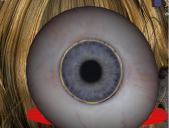Eyes troubles after smoothing
Hello everyone!
I created some d-formers for G2F's head, than i made a morph of them and applyed it. After that i used smoothing modifier and here is what happend with characters eyes after that (see the picture; character's head is set to invisible mode). I suppose this happened because my d-formers influenced the eyeballs of character, but perhaps it isn't the reason. Does anybody have an idea how can i fix this and still use my morph and smoothing modifier?


2016-12-03 23.21.39.png
1023 x 775 - 1M
Post edited by ant2505 on


Comments
And now i found out, that smoothing modifier disfigures G2F's STANDARD long nails. I could understand if it was some sided content creator's long nails, but this is standard G2F's =/. Any idea how to fix this?
A smoothing modifier is just that - a way of modifying a mesh (actual adjusting the location of the mesh vertices) to reduce sharp changes. If those sharp differences in the mesh are necessary to create a certain effect, then applying a smoothing modifier is going to diminish that affect or appearance - that is exactly what it is intended to do. When using a smoothing modifier it is always important to use the iterations judiciously. The greater the number of iterations you use, the greater impact the smoothing modifier will have. You need to experiment to see what the best balance is between preserving the morphs and correcting whatever problem you are trying to correct. If you find that there is no acceptable balance between the two, then perhaps using a smoothing modifier at all is not the answer. Perhaps you need to revisit the morphs and make adjustments there to correct whatever problems you are encountering.
Edit: Oh, yes, the eyeball thing. That does not look like the result of the smoothing modifier itself to me. I think you are guessing correctly when you wonder if one of your D-Formers caused that. The head is a tricky area to use D-Formers, since it is the one area of the model that has a lot of internal mesh. If you are working in smooth shaded mode in the viewport you can easily grab some of those internal vertices by mistake with the field and not notice. It is a good idea under such circumstances to toggle between smooth shaded and wireframe modes to reveal any such potential problems before moving the mesh. It is a tricky area in which to work and demands some fine tuning of the D-Former fields to avoid such issues. This is were modelling programs have a big advantage, since they not only have a greater variety of tools to work with, but changes can be much more precisely limited to selected areas only, including smoothing if necessary.
Also, since one can now apply weight painting to D-formers, that would be another way to control/restrict the fields in 'close quarters'.
Actually, I haven't used that option, mjc. Sigh, another notch on the ever-growing todo list. No wonder I never get anything done, I'm too busy making notes about things I should do.
Solved, guys! Here is the answer how:
http://www.daz3d.com/forums/discussion/5983/problem-with-smoothing-modifier-ds-4-5-solved
Thank you for answering!
Yes, ant, however you need to be careful if you switch from Base Shape Matching to Generic. If you use that on a base figure, unless the iterations are very low it will cause significant changes that will completely alter not only your morphs, but the entire appearance of the base figure, since the constraints imposed by Base Shape Matching will not moderate any changes.
Here's an example using a simple cone primitive (twelve sides, twelve segments for a total of 166 faces). Figure 1 shows the original cone, Figure two shows the cone with a smoothing modifier enabled using Base Shape Matching with 50 iterations and Figure 3 shows the cone with a smoothing modifier enabled using the Generic option with 50 iterations. Perhaps an extreme example, but it illustrates what can happen.